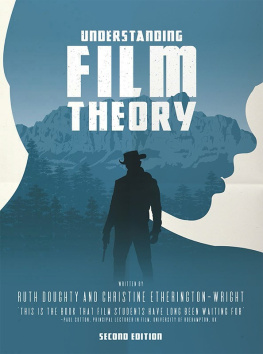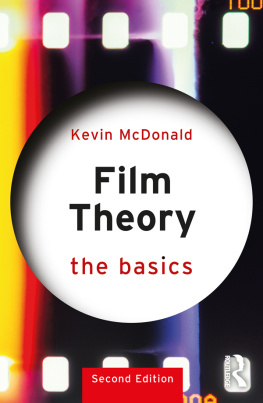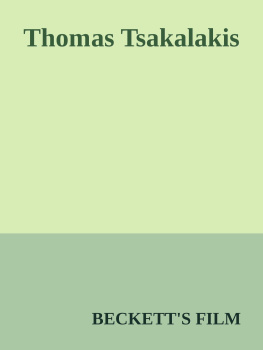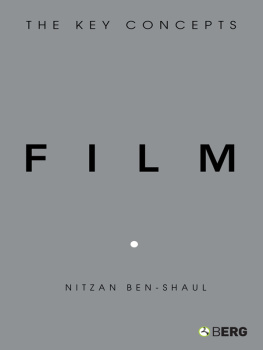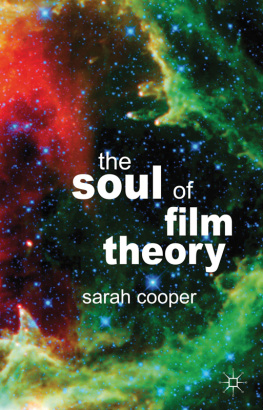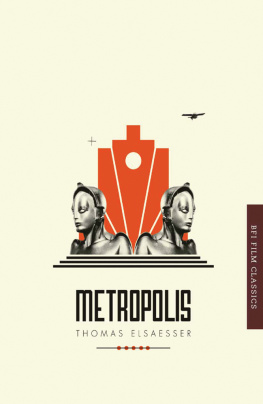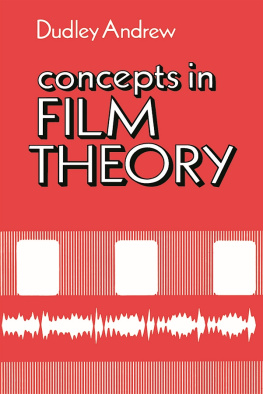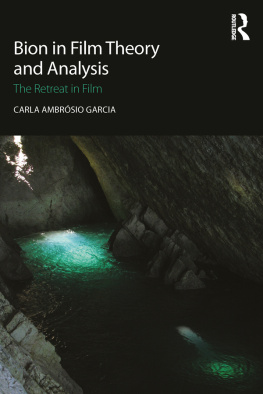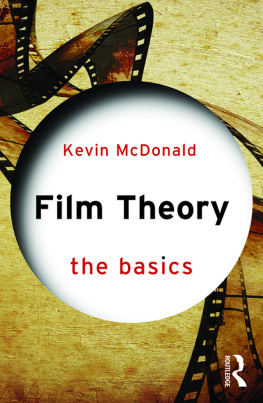Elsaesser Thomas - Film Theory
Here you can read online Elsaesser Thomas - Film Theory full text of the book (entire story) in english for free. Download pdf and epub, get meaning, cover and reviews about this ebook. publisher: Taylor and Francis, genre: Politics. Description of the work, (preface) as well as reviews are available. Best literature library LitArk.com created for fans of good reading and offers a wide selection of genres:
Romance novel
Science fiction
Adventure
Detective
Science
History
Home and family
Prose
Art
Politics
Computer
Non-fiction
Religion
Business
Children
Humor
Choose a favorite category and find really read worthwhile books. Enjoy immersion in the world of imagination, feel the emotions of the characters or learn something new for yourself, make an fascinating discovery.
- Book:Film Theory
- Author:
- Publisher:Taylor and Francis
- Genre:
- Rating:4 / 5
- Favourites:Add to favourites
- Your mark:
- 80
- 1
- 2
- 3
- 4
- 5
Film Theory: summary, description and annotation
We offer to read an annotation, description, summary or preface (depends on what the author of the book "Film Theory" wrote himself). If you haven't found the necessary information about the book — write in the comments, we will try to find it.
Film Theory — read online for free the complete book (whole text) full work
Below is the text of the book, divided by pages. System saving the place of the last page read, allows you to conveniently read the book "Film Theory" online for free, without having to search again every time where you left off. Put a bookmark, and you can go to the page where you finished reading at any time.
Font size:
Interval:
Bookmark:
Second edition published 2015
by Routledge
711 Third Avenue, New York, NY 10017
and by Routledge
2 Park Square, Milton Park, Abingdon, Oxon OX14 4RN
Routledge is an imprint of the Taylor & Francis Group, an informa business
2015 Taylor & Francis
The right of Thomas Elsaesser and Malte Hagener to be identified as authors of this work has been asserted by them in accordance with sections 77 and 78 of the Copyright, Designs and Patents Act 1988.
All rights reserved. No part of this book may be reprinted or reproduced or utilised in any form or by any electronic, mechanical, or other means, now known or hereafter invented, including photocopying and recording, or in any information storage or retrieval system, without permission in writing from the publishers.
Trademark Notice: Product or corporate names may be trademarks or registered trademarks, and are used only for identification and explanation without intent to infringe.
First edition published by Routledge 2010
Library of Congress Cataloging-in-Publication Data
Elsaesser, Thomas, 1943
Film theory : an introduction through the senses / Thomas
Elsaesser and Malte Hagener. Second edition.
pages cm
Includes bibliographical references and index.
1. Motion pictures. I. Hagener, Malte, 1971 II. Title.
PN1994.E53 2015
791.43dc23
2014037890
ISBN: 978-1-138-82429-4 (hbk)
ISBN: 978-1-138-82430-0 (pbk)
ISBN: 978-1-315-74076-8 (ebk)
Typeset in Perpetua
by Apex CoVantage, LLC

REAR WINDOW Constructivism Realism Open and Closed Film Forms (Leo Braudy) Classical Cinema Central Perspective Rudolf Arnheim Sergei Eisenstein Andr Bazin David Bordwell Cinema as Shop Window and Display
THE SEARCHERS Entry into the Film Etymology of Screen Thresholds of the Cinema Beginnings: Credits and Credit Sequences Neoformalism (Bordwell/Thompson) Poststructuralism (Thierry Kuntzel) Mikhail Bakhtin Door and Screen as Filmic Motifs in Buster Keaton and Woody Allen
PERSONA Bla Balzs Close-Up and Face Face as Mirror of the Unconscious Christian Metz Jean-Louis Baudry Apparatus Theory Early Cinema and the Close-Up (Tom Gunning) Reflexive Doubling in Modern (Art) Cinema Mirror Neurons Paradoxes of the Mirror
BLADE RUNNER Active and Passive Eye The Mobile Eye of Early Cinema Dziga Vertov Apparatus-Theory Suture Continuity Editing Laura Mulvey Feminist Film Theories THE SILENCE OF THE LAMBS Historicity of Modes of Perception Regimes of the Gaze The Big Other (Jacques Lacan) Slavoj iek Panoptic Gaze (Michel Foucault) Niklas Luhmann and Self-Monitoring
GRAVITY (Re)turn to the Body Critique of Oocularcentrism Phenomenology, Synaesthesia, Intermodality Vivian Sobchack Avant-Garde Practices Body and Genre (Linda Williams, Barbara Creed) Haptic Perception and Skin of Film (Laura Marks) CRASH Skin and Identity THE NEW WORLD Accented Cinema (Hamid Naficy) Ethnographic Filmmaking Siegfried Kracauer
HER Multisensory Address Sound as a Spatial Phenomenon Silent Cinema Introduction of Sound SINGIN IN THE RAIN Sound in Classical Cinema On-Screen/Off-Screen Polysemy of Sound Acousmtre (Michel Chion) Sound and Psychoanalysis Reversals in Hierarchy of Image and Sound Surround Sound Materiality and Plasticity
ETERNAL SUNSHINE OF THE SPOTLESS MIND Propaganda and Cult Films Five Concepts for Connecting Mind and Cinema Gilles Deleuze: Movement-Image and Time-Image Annette Michelson: Cinema as Epistemology Torben Grodal Patricia Pisters: Neuro-Image Mind and Body, Spectator and Film Empathy Embodiment and Disembodied Vision
TOY STORY Hybridity and Embedded Contradictions Lev Manovich and Sean Cubitt Virtual Reality, Media Convergence Indexicality Morphing and the Malleability of the Digital Media Archaeology and Remediation Change Inside-Out Video Essays MONSTERS, INC. Fan Labour Public/Private Documentary and the Digital Things and Materiality Agency
This book originated in a series of seven lectures that were first given by Thomas Elsaesser at the University of Amsterdam in 20052006 to the international M.A. students in Film and Television Studies, and were subsequently expanded for an undergraduate seminar at Yale University. Commissioned by the publishing company Junius Hamburg to write an introductory guide to film theory for their series Zur Einfhrung, Elsaesser asked Malte Hagener to be his co-author. Hagener not only translated Elsaessers lectures and class notes into German, but also fleshed out the text with his own observations, arguments, and analyses.
The German version was published in November 2007, aided and abetted by the critical and constructive support of Balthasar Haussmann and Steffen Herr-mann. The positive response to the German edition encouraged us to approach Routledge, where we found in Erica Wetter an enthusiastic partner. Much of the German text was revised and rewritten, and we owe thanks to Gabriele Stoicea, our initial translator, as well as to members of Elsaessers 2009 Yale graduate class Michael Anderson, Ryan Cook, Michael Cramer, Victor Fan, Seunghoon Jeong, Patrick Noonan, and Jeremi Szaniawski who acted as the new versions first readers. Thanks are also due to the various anonymous Routledge readers, who made a number of insightful criticisms. Ryan Cook deserves our special gratitude for finding appropriate illustrations, while Warren Buckland, Ria Thanouli, Craig Uhlin, Damian Gorczany, and Patricia Prieto Blanco made further helpful suggestions.
The strong response to the first English edition, as well as several reprints of the German edition and translations into other European and Asian languages, have shown us that the book filled a demand bigger than originally anticipated and that the model inaugurated in the book of how to understand film theory as intimately related to each spectators body and senses has proven productive and persuasive to both colleagues and students. Given the response we received, and in light of changes in cinema theory and practice, we felt it appropriate to prepare a new edition which corrects a number of mistakes but mainly enlarges on parts that were all too brief in the first edition or have gained in significance. We hope the new version of Film Theory: An Introduction Through the Senses retains the advantages of the first edition providing a concise, yet original introduction to film theory focused on a specific question and adds to it by giving the central argument a further reflexive turn.
While the main body of the text has not been radically changed, each chapter has been carefully revised and numerous passages rewritten, adding new references, updating the films, and incorporating theoretical issues that help to refine or cast new light on our existing arguments. The conclusion in the first edition conceived as a tentative gesture towards an open future has been greatly expanded and mostly rewritten. It is now a standalone eighth chapter, which brings film theory up to date in the digital age.
In addition to the acknowledgements due for the first edition, we wish to thank a number of colleagues who have selflessly shared their working experience with the book. Detailed classroom reports were filed by Walter Metz, David B. Olsen, Rikke Schubart, and one anonymous colleague, giving us valuable insights from different perspectives. Catherine Grant, Adrian Martin, Cris-tina lvarez Lopez, and Volker Pantenburg, all champions of the video essay, have not only shaped our thinking about this emerging form but have also provided commentary and suggestions for the website, which is accompanying the release of this edition. At Routledge, Erica Wetter and Simon Jacobs have expertly guided us through the editorial process. We hope that this book will continue to provide a map for the expanding field of film theory, as well as give rise to fresh ideas and new arguments that will further invigorate a field that seems to thrive on passionate self-interrogation, as it manages to turn a crisis into an opportunity to reinvent itself.
Font size:
Interval:
Bookmark:
Similar books «Film Theory»
Look at similar books to Film Theory. We have selected literature similar in name and meaning in the hope of providing readers with more options to find new, interesting, not yet read works.
Discussion, reviews of the book Film Theory and just readers' own opinions. Leave your comments, write what you think about the work, its meaning or the main characters. Specify what exactly you liked and what you didn't like, and why you think so.


